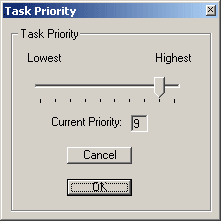RAIDCore Unleashes SATA to Take Out SCSI
Not New, But Useful: Prioritization
Actions that can impact the performance of a RAID array can be prioritized in RAIDCore. This allows a rebuild to be done either as fast as possible or with the least impact on performance - that is in the hands of the administrator. This is exactly how LSI does it; although Adaptec supports the assignment of a priority in three stages, this only refers to the initial build of an array. 3Ware supports prioritization in five stages.
The priority of all background operations can be controlled with this slider.
Continuous Data Checking
With as short a time as we had, we were not able to check this feature because it is a service that is part of the Fulcrum Architecture. The better reason for this is that even those sectors of the media that are hardly used should be checked now and again to make sure they are readable. This will allow failures to be predicted, because read errors are often the precursors of media failures. This feature is commonplace, but it is always called something different. Adaptec calls it Background Consistency Check.
Easy Disk Migration
As the Fulcrum Architecture (details in the section on the controller) is designed to be extremely flexible and can be transferred to a wide range of hardware, the drives and arrays used should be interoperable. The data recorded should thus be usable on all devices based on Fulcrum.
Drive Roaming
Get Tom's Hardware's best news and in-depth reviews, straight to your inbox.
Many of you are already familiar with the term "roaming" from mobile technology. What is meant is the use of a SIM card in a network of another provider. It's sort of the same with RAIDCore: Each drive is clearly identified, which is why it can be connected to any port on the controller.
Arrays Of More Than 2 TB
What is not yet even worth mentioning in home use already plays a major role in professional settings: the 2 TeraByte limit. Although NTFS supports drive sizes of up to 264 Bytes or 16 ExaBytes (Giga - Tera - Peta - Exa), the allocation tables are only 32 bit. With 512 Bytes per sector, the most common until now, 232 x 512 Bytes result, in other words 2 TeraBytes. The Fulcrum Architecture is therefore also flexible in terms of the physical parameters.
Cache As NVRAM With Battery Buffer
This is not an invention of RAIDCore's, but is expected and thus supported. In order that cache information is not lost in a sudden power loss (particularly critical is data that is in the cache memory and has yet to be written), a so-called NVRAM cache (non-volatile RAM) is used. It uses normal memory chips, which, however, are buffered with a battery. When the system is restarted, the RAID controller writes the remaining data in order to ensure consistency in the data.
Current page: Not New, But Useful: Prioritization
Prev Page Fulcrum: Features Beat Adaptec And LSI Next Page Several Arrays On One Hard Drive
Patrick Schmid was the editor-in-chief for Tom's Hardware from 2005 to 2006. He wrote numerous articles on a wide range of hardware topics, including storage, CPUs, and system builds.
